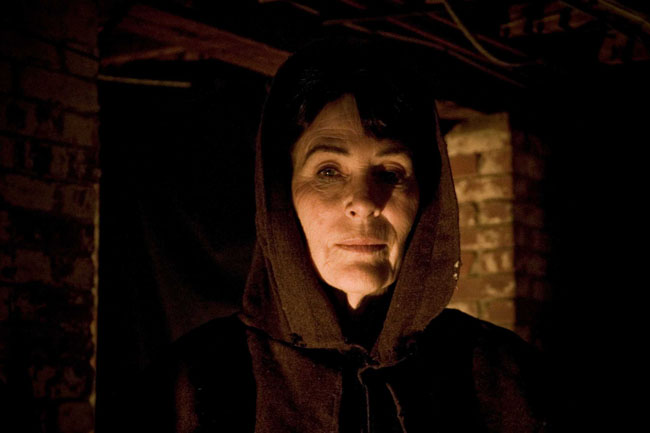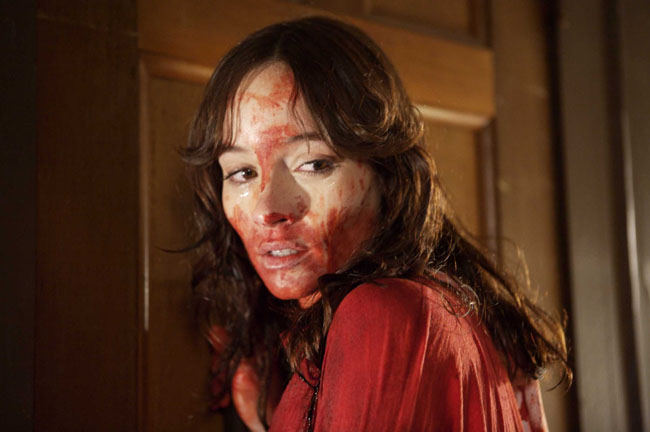CHICAGO – Excelsior! Comic book legend Stan Lee’s famous exclamation puts a fine point on the third and final play of Mark Pracht’s FOUR COLOR TRILOGY, “The House of Ideas,” presented by and staged at City Lit Theater in Chicago’s Edgewater neighborhood. For tickets/details, click HOUSE OF IDEAS.
Interview: Director Ti West on ‘The House of the Devil’ at Chicago International Film Festival
CHICAGO – Discovering young filmmaker talent is one of the most exciting elements of the Chicago International Film Festival. Writer/director Ti West is one of those discoveries, with his horror film premiere, “The House of the Devil.”
West has been building a resume since 2001, with his directorial debut “Wicked.” The House of the Devil is his fourth film, and has a horror/suspense feel that seems like the era he has set the film, in 1983.
 Photo credit: © Magnolia Pictures |
Samantha (Jocelin Donahue) is a poor college student, who desires a new apartment but doesn’t have the deposit. A mysterious sign for a babysitter piques her interest, and the mysterious gentleman (Tom Noonan) finds her perfect for the job. The assignment involves a big house and some inexplicable noises, and what the sitter must oversee might be more than she expected.
The atmosphere created in West’s narrative evokes a 1983 vibe, while at the same time being wholly original. It even uses effective casting, with 1980s stalwarts Dee Wallace and Mary Woronov decorating the scenery with their pitch perfection.
HollywoodChicago interviewed Ti West, groggy after his late night Q&A and screening of The House of the Devil at the Chicago International Film Festival on October 9th. He spoke of doing a period 1980s horror film that does more than just generate nostalgia.
HollywoodChicago: It is obvious this film is a throwback to the horror films of a certain era. What do you think was the biggest challenge of fulfilling that certain look and feel?
Ti West: I don’t think it was much of an homage as it was a period piece. There are elements to it that are affectionate to films of that time, but I thought of it more as a movie set in 1983. I tried to be as accurate as possible with that.
The biggest challenge was financially, we were a pretty small movie. Doing a period piece on such a small scale is very difficult. But I worked with a really good crew for a couple years now and we’re on the same wavelength. I was very specific about things, and they really got it.
HC: You were born in 1980. When did you become enamored of films of the era you’re aping and how did you begin to apply that feeling in your work?
TW: I’m an only child, and I was pretty much raised by TV and movies. As much as most people’s formative years are in there teens, it was much younger for me, and I was over-saturated with what I was watching.
How that integrated into my work, I think it’s subconscious and case specific. Everyone is saying, ‘you really know 1980s movies’ or ‘it feels like an ‘80s movie’ and I say well I was making an ‘80s movie. If I was making a movie that was made in the 1950s I don’t think I’d be hip to the ‘80s (laughs). There is an element that in this particular movie, that is what we were striving for.
The 1980s were the last decade before MTV style editing or before music video directors became feature directors. This was an era where even schlocky horror movies were treated like regular movies. They weren’t test screened or market researched that much. They left that to the advertisers and left the film to be what it was. In the 1990s that was all phased out.
HC: You were looking for a “type” in this film for the lead. What was it about Jocelin Donahue that fulfilled your criteria?
TW: I guess it was a couple things. First, she really understood the film. I had many in the audition say ‘cool, a scary movie.’ It was way more like an arty independent movie and if you didn’t understand that, it wasn’t going to pan out. In Los Angeles, we had a lot of ‘babes’ coming in, but they didn’t get the sensibility.
But Jocelin understood it and understood the tone I was going for. That made it much easier. Secondly we got along, which made it easier still.
 Photo credit: © Magnolia Pictures |
HC: The build-up of suspense is a subtle psychological function in filmmaking. What determined for you the timing of your suspenseful elements and what type of discussions did you have about it on set and in the editing bay?
TW: There wasn’t a lot of discussion, because I wrote, directed and edited the movie. I discussed it in my head with myself.
The movie was what it was – a girl in a house alone hearing noises. That was just the game plan. I once read an interview with Roman Polanski, when he was talking about ‘Repulsion’ and he was saying for that film to be effective you had to bring the audience to the brink of complete and utter boredom, then hit them with something crazy. That would jolt them from their seat and suddenly you have this very proactive audience.
That is a very effective statement about horror movies being about suspense and contrast. If you don’t have a strong contrast between horror and non-horror moments, then it’s just mediocre and boring.
HC: Classic actors of the era, Dee Wallace and Mary Woronov have roles. Did you seek advice from them about either what you were trying to accomplish or just simply technique differences from then to now?
TW: I really didn’t seek advice from them, but in hindsight that might have been beneficial (laughs). They are just two actors that I have admired forever. And Mary especially. She doesn’t act anymore, so I had to go to her house and pry her out of retirement to do it.
I’ve also really loved Dee. And it worked that she was traveling right near the set at the right time, and she came out for the day to do the movie.
HC: Tom Noonan’s creepy presence seems very powerful in the first third of the film. How did you approach the interplay between Noonan and Jocelin Donahue to get that effect?
TW: Tom and I had done a movie before, so we had a pretty good shorthand at this point. He doesn’t like to talk about acting that much and neither than I. I just told him I wanted him to be this henpecked husband type of guy. To be a little creepy but no so menacing and scary that no one would want to stay in the house.
Tom generally is an awkward guy. He’s a weird dude. Jocelin didn’t know him. Those scenes in the house were the first couple days that they knew each other. It literally was awkward for her. Tom I think takes a lot of enjoyment from people’s real, uncomfortable emotion. He saw that she thought he was weird, and just played off of that.
HC: Women as victims is an overriding theme in horror. Besides just the ability to overpower them, what vulnerabilities do women have that fascinates you in a victimization sense?
TW: There is an element that it has been going on for so long that I have fallen in the same trap. I couldn’t imaging a babysitter movie with a guy.
But also I wanted to make sure that Jocelin’s character in the movie was a real person and wasn’t calling her boyfriend crying, and was able to defend herself. I didn’t want her to be Sigourney Weaver and start knocking everybody out either, but I wanted her to be real.
I’m really fascinated when you’re in a stranger’s house by yourself. And the things you do outside your personality, like snooping around and looking at stuff. That’s not what you do, but you can’t help it. So I wanted to make the character as someone everybody could relate to. A real person stuck in an unreal situation.
Photo credit: Patrick McDonald for HollywoodChicago.com |
HC: Religion is a touchy subject when is comes to categorizing good and evil. Why has ‘Devils’ and ‘Satanic Cult’ become scapegoats, in your opinion, for the evil that man seems to have no problem generating on his own?
TW: It’s safer than reality. I think even deeply religious people, I don’t know if they expect the devil to pop out and start exploding the world. It’s a far-fetched fear that we can all gauge things against because it’s never really going to come into play. It’s a safe fear.
The satanic ‘panic’ of the early 1980s was a theme for this film. There was about 3-4 years that Geraldo Rivera was telling us there were cults when there wasn’t. People really thought it was happening. Of all the things that we latch onto at the time, that was it. Everyone was looking for the contrast.
HC: The natural phenomenon of the eclipse of the moon is very effectively used. What is it about our nature that invites superstitions and even horror in phenomenon like that?
TW: It’s just so arcane and old. The real reason is that it was a horror movie-type goof thing (laughs). I wanted to have something in there that felt like a culturally relevant, non-human controlled thing that was happening, that elevated the plot a bit. The moon also subconsciously scares us, and that gets pulled in.
HC: What directors give you the biggest buzz in creating your film sensibility? What three films would be shown in your film class and why?
TW: If I had a film class referencing House of the Devil I would show ‘The Tenant,’ ‘The Changeling’ and ‘The Shining.’ I’m not someone who specifically draws from other films, but those are auteur-ish, someone left of center horror movies.
The way those three directors – Roman Polanski, Peter Medak and Stanley Kubrick – handled the themes in each one of those, in an auteur-like approach to horror, was to treat them with respect. That is what elevated those movies.
HC: You have released this film on video-on-demand (VOD), Amazon VOD and Xbox Live as a cutting-edge system of distribution. Where do you see the future of movie viewing evolving and is it good or bad to you?
TW: It is evolving toward more home watching, like VOD. At first I was very against it, a couple years ago, but I’ve come around to realize that everyone wants to go back to the way it was. But you never can.
The good thing about VOD is that for markets that don’t have access at the same time they can be seeing the movie. So that the same time Chicago shows it at the Music Box Theater, for example, someone in Des Moines, Iowa, can see it too. And although that is not as romantic a home, it does give them a home where they can have accessibility to it.
 | By PATRICK McDONALD |


